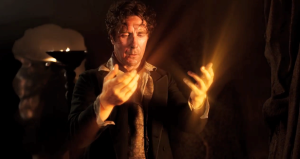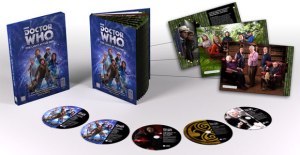 |
| Image Copyright BBC 2013 |
Well... That was rather brilliant, wasn't it? As the title of this entry suggests, there will be spoilers in this review. As a series finale, and such an important story, it'd be almost impossible to review it without mentioning things that will spoil the episode for those who've yet to see it. If you're one of those, I suggest you turn away now - go to iPlayer and WATCH the episode. Trust me, you will not be disappointed.
Okay, so let's start at the beginning. What a pre-title sequence that was! A fans' dream come true. Although, I think, it was a bit overkill to show it all again near the end of the episode, but I'm not complaining too much. Seeing Clara almost meeting the Second, Third, Fourth, Fifth, Sixth and Seventh Doctors was rather special, and was done in a rather clever way. Either by putting Jenna-Louise Coleman into footage of previous stories, or watching body doubles walk by her slightly out of focus. Of course, from a purely fan point of view, I must wonder what adventures she was interacting with. The corridor from which she views the Seventh Doctor never appeared in Dragonfire (the story from which the McCoy footage was lifted), and she appears to be looking through a window at the Fifth Doctor, even though he's in the Matrix ala Arc of Infinity. Minor quibble, but odd nonetheless. The most interesting part of this pre-title sequence, however, is Clara meeting the First Doctor on Gallifrey 'a very long time ago', as he ushers Susan into a TARDIS - the moment upon which every single episode of Doctor Who is based. It's amazingly well done, and confirms, for the first time on television, that the Doctor and Susan did leave Gallifrey together! (But there's a better twist to this scene coming up near the end of the episode - so we'll get there later.)
Despite these appearances of past Doctors, it takes a good ten minutes for the Doctor to actually get involved in the story-proper, since we have more screen time devoted to Madame Vastra, Jenny and Strax. This, in itself, is no bad thing. I for one would love to see a spin-off series with these characters - a nice Victorian Gothic-comedy-detective series. Vastra learns that someone has discovered the Doctor's secret on Trenzalore, and so initiates a psychic conference call with both Clara and River Song. It's brilliant to see River back, and this time the River we last saw in 2008's Silence in the Library - yes, the one who died to save the Doctor! It works perfectly well, she is an echo of River's mind that was uploaded to the moon-sized hard drive orbiting the Library. It's another amazing performance by Alex Kingston, possibly her best yet, and it is nice to see her playing the more mature, and sad, River who we first met. There's some wonderful interaction between River and Clara, who is surprised to learn that River knows the Doctor's name, although River refuses to explain how she made him tell her.
Enter the Doctor. Another assured and reserved performance by Matt Smith - easily his best yet. He taps into the Doctor's soul-destroying sadness, but still carries the iron resolve one expects from the Doctor, when he determines to go to Trenzalore and face his own future. For it is on Trenzalore that the Doctor is buried. Or is he? It's a little complicated when he gets there, and we're shown the impressive monument in which the Doctor's future resides. The TARDIS!
What a sight it is! The dimensional dams have broken down, and as a result the Police Box shell is now bigger on the outside, towering over the graveyard of Trenzalore. We follow the Doctor and Clara through this future TARDIS interior, with scenes that are by far more interesting than those shown a few weeks back in Journey to the Centre of the TARDIS, and Clara begins to remember what she forgot in that episode, including the conversation she had with the Doctor in which she discovered that he keeps on meeting her. The reason for this is finally revealed when they reach the console room of this future TARDIS - which is the current console room, only overgrown with foliage. This is a bit of a puzzle. If this is far in the Doctor's personal future, why is the console room still his current one? The Doctor goes through console rooms like most people go through socks, you'd expect this future console room to be something entirely new and previously unseen.
In this console room we see that, instead of his body ('bodies are boring...I've had loads of them'), the TARDIS tomb holds the Doctor's time stream, the 'scar tissue of my journey through space and time'. There the Great Intelligence (played with sinister panache by Richard E Grant) casts himself into the Doctor's timeline, to corrupt and destroy it - turning every victory of the Doctor into defeat. And it is here that we learn the truth about Clara. She comes to realise the reason for the echoes of her is because of this moment - that she has to cast herself into the Doctor's timeline and save him. It is at this point that we come to understand why she exists throughout time, always encountering the Doctor, and why she tells the Doctor to 'run, you clever boy. And remember me'. I do, however, have a little quibble here. Up until this point none of the Claras have known the Doctor when they met him - although they have all been compelled to help him. But when she's scattered and interacts with the past Doctors, she appears to know who he is, even to the point of telling the First Doctor that he should steal the TARDIS she's standing by, and not the one he just pushed Susan into. It may have a faulty directional unit, but it will be much more fun! Basically, it's Clara who sets the Doctor on his journey through time in his 'rackety old TARDIS'. This point does contradict what we learned in 2011's The Doctor's Wife, when the TARDIS tells the Doctor that she stole him, and not the other way around. A minor point, but still... It doesn't take away from the greatness of the moment, though, seeing the First Doctor on Gallifrey prior to the very first episode of Doctor Who fifty years ago.
 |
The First Doctor steals the TARDIS from Gallifrey
(image copyright BBC 2013) |
This sets the scene for the final moments of what, we discover, is actually the first of a two-part anniversary story. Set within the Doctor's time stream, Clara sees echoes of various Doctors, and every single Doctor is seen in some way or another, except the Eighth Doctor. Why this omission? The Doctor follows Clara into his own time stream, his 'every good day, every bad day'. Here Clara explains that she's seen ALL the Doctors, all eleven of him, so who is that man standing with his back to them?
The surprise reveal is John Hurt - playing 'not the Doctor', despite the on screen credit. The Doctor makes a point of saying that this man is not the Doctor, but rather his secret, the one who broke the promise. Did everything that isn't the Doctor. It's a little vague, but enough to suggest that John Hurt's character is the truth behind the Doctor, the man he really is, the man he was, the identity hidden beneath the façade of 'the Doctor'...
So, my verdict? I have to confess I rather loved it. For the first time since Steven Moffat took over as executive producer, I've seen an episode I actually loved. I'm not saying it's perfect (name one episode of Who that is), but it's certainly something I can watch a few times without getting bored. The interaction with past Doctors was wonderfully handled, even to the point of adding grain to the screen to give it an old video-tape look, and we got to see River say her final goodbye to the Doctor. Plus the ever-entertaining Strax! But, here's my one big gripe: what secret was revealed? Other than John Hurt, we never got the Doctor's greatest secret revealed to us. No name was uttered (except by River out of earshot), no further clues as to Who the Doctor is. Just that we know he dies in battle on Trenzalore, and deep within his timeline exists the man behind the myth - the dark secret. We did, however, get a mention of the Valeyard ('every evil impulse of the Doctor' who appeared in 1986's The Trial of a Time Lord), which may be an important connection to this John Hurt not-Doctor.
Perhaps the second part of this story, in November, will be more enlightening?
Also, one last time, why no Eighth Doctor? I wonder...
 |
| Image Copyright BBC 2013 |
Andy Frankham-Allen

















